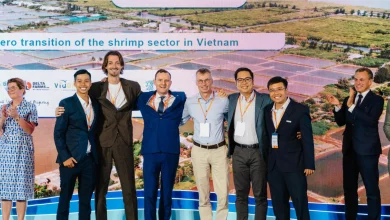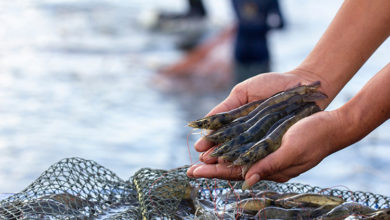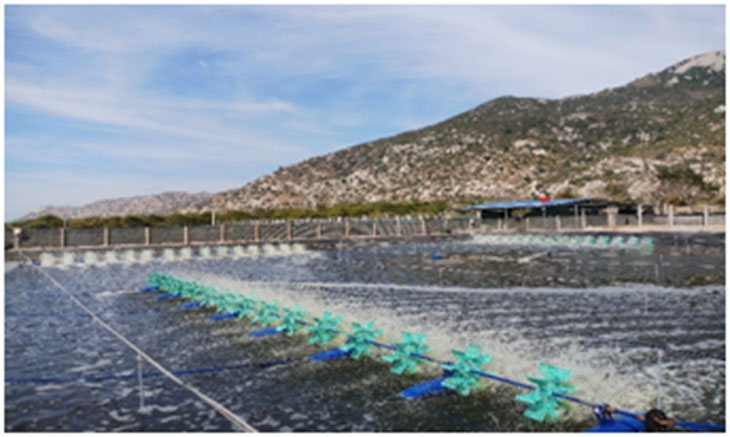Vietnam Food: Turning waste into value
The management and reuse of by-products have become urgent issues in Vietnam's shrimp industry amidst ongoing challenges. With a vision of sustainable development, Vietnam Food Joint Stock Company (VNF) actively seeks solutions to convert shrimp by-products into valuable resources. Nguyen Van An, Strategy Director of VNF, discusses the company’s efforts in utilizing by-products, while highlighting the importance of biotechnology in enhancing product value and fostering sustainable growth for Vietnam’s aquaculture industry.
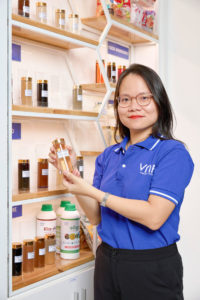
VFM: Could you share about your role at VNF and your journey with the company over the years?
Nguyen Van An: I am Nguyen Van An, currently the Strategy Director at VNF. The company has been operating in Vietnam for 10 years, and I have been with VNF for nine of those years. I have been with the company since its early days, when it was still very small. Today, VNF has grown with two factories and a research center. Initially, we focused only on the domestic market, but now export a wide range of products. It has been a long journey, and I am very proud to have contributed to the company’s development.
VFM: Why did VNF follow the by-product sector, and what made you decide to join this field at VNF?
Nguyen Van An: Since its founding, Mr. Phan Thanh Loc, Co-founder, Chairman of the Board, and CEO of VNF, has been dedicated to identifying an industry that could leverage Vietnam’s internal strengths and have the potential to compete in the international market. After researching various sectors, he recognized that the by-product industry was a promising choice.
At that time, agricultural by-products were often discarded, contributing to environmental pollution. Loc realized that, if properly managed, these by-products could be transformed into valuable resources. He recognized that it was time to turn them into something of value. Moreover, agriculture is a key pillar of Vietnam’s economy, and by-products play an essential role in this value chain.
Drawing on my experience working with an investment fund, I chose to invest in VNF to explore the potential of the by-product industry. I was tasked with supporting VNF during its early stages, and since then, I have been with the company from its inception, contributing to its growth into the pioneering business today.
VFM: VNF is a pioneering company in processing shrimp by-products in Vietnam. Over the past 10 years, how has the company transitioned from a linear economy to a circular economy, turning shrimp by-products into valuable ingredients and generating significant benefits for the country?
Nguyen Van An: When it was first established, VNF operated under a linear economic model, primarily purchasing shrimp by-products to produce glucosamine and selling raw materials to dietary supplement manufacturers. However, after about one to two years of operation, we realized that this model was not sustainable. The chitin production process resulted in pollution, consumed many chemicals and resources, and generated large amounts of waste that were difficult to manage.
To address these issues, we have analyzed and referenced several international models. Abroad, by-products have been effectively processed for a long time. Many dietary supplements, such as glucosamine and collagen, are derived from fish and shrimp by-products; however, we have yet to fully recognize this potential.
We recognize the great potential of the by-product industry through research, but it requires significant investment in science and technology. If we only produce and sell raw products, their full value potential will not be tapped.
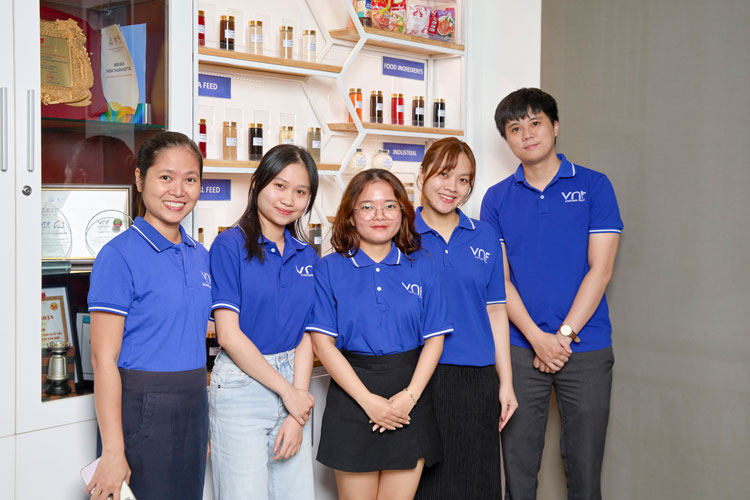
Therefore, VNF has decided to invest in extraction technology and conduct further research on shrimp by-products to identify active ingredients and extractable materials.
We have discovered that shrimp by-products contain a variety of nutrients, including protein, lipids, chitin, and other micronutrients. In particular, shrimp shells are rich in astaxanthin, often referred to as the ‘king of antioxidants’ due to its exceptionally high potency. Building on these findings, we have developed extraction technology to create our current products.
With the available raw materials, VNF continues to research and develop applications for various industries. We have observed that the agricultural sector in Vietnam faces numerous challenges that could be addressed by by-products. One of the most significant issues is the heavy reliance on imported raw materials, as 80% of Vietnam’s agricultural raw materials are imported, particularly fishmeal and additives. The protein content in by-products is of high quality, which is why we are focused on transforming this protein source into solutions for the livestock industry.
In addition to providing a protein source for animal feed, we also extract other ingredients, such as Astaxanthin and Chitosan, reducing the need for additives and even antibiotics. At the same time, we are expanding our applications in agriculture, food, and other industries.
VFM: VNF was honored to win the Innovation Award in the Future of Nutrition category at Fi Global 2019 (Paris), becoming the first Asian company to be recognized in this category. This is undoubtedly one of VNF’s greatest achievements. Could you share more about this significant milestone?
Nguyen Van An: As of 2019, VNF’s food division had been operating for only two years. We participated in Fi Global 2019 in Paris with the hope of introducing our solutions to international partners. However, we were pleasantly surprised when we received an invitation to Paris to present the solutions that VNF is developing.
VNF recognizes that this is a prestigious global award in the field of food technology. Interestingly, these awards often attract large companies, while small companies from Asia typically have fewer opportunities to participate. Therefore, I am very pleased that VNF has the chance to be involved.
At Fi Global 2019, VNF was honored to receive the Innovation Award in the ‘Nutrition for the Future’ category. Our solutions, developed from by-products, were highly praised and recognized for their potential to become future nutritional solutions for humanity.
It is truly an honor for us, and it serves as motivation for VNF to continue growing and innovating in this field. This success not only affirms the value of our efforts but also opens up many opportunities for us to contribute to addressing nutrition-related challenges in the future
VFM: Many industries, including the seafood sector, are transitioning toward a circular economy model. Based on real-world experience, could you share more about the challenges faced by the seafood industry and the opportunities for development presented by this model?
Nguyen Van An: When VNF first began developing a model to utilize shrimp by-products for agricultural reuse, we were not yet familiar with the concept of the circular economy. At that time, VNF viewed it primarily as a sustainable business model—not only for the shrimp industry but also for the Vietnamese economy. However, through further research and exploration of ESG (Environmental, Social, and Governance), we realized that this model aligns perfectly with the principles of the circular economy.
Many favorable factors have created opportunities for us. This is a global trend, and Vietnam cannot be excluded. By embracing this trend early, we will gain a significant competitive advantage over other companies. Currently, the majority of VNF’s customers and partners are looking for suppliers or partners with sustainable models. As a result, we are receiving support from both consumers and stakeholders.
However, the challenges are significant. The shrimp by-product industry, both in Vietnam and globally, still lacks sustainable extraction technologies. Most current methods focus solely on extracting a specific ingredient, often neglecting other components. This is in contrast to the fish by-product industry, which has been developed over many years. Shrimp by-products are particularly complex, as the shell and the meat have entirely different properties. Therefore, a technology capable of processing both parts simultaneously is needed, but very few companies are willing to invest in research.
As one of the pioneering companies, VNF invested significant time and resources into models that ultimately were not successful, but from which valuable lessons were learned with improvements. We had to convince both suppliers and employees that technological change was essential. Initially, VNF operated as a traditional chitin manufacturing company with low-tech processes. Changing the mindset was a challenging task, but the VNF team united and moved forward as one.
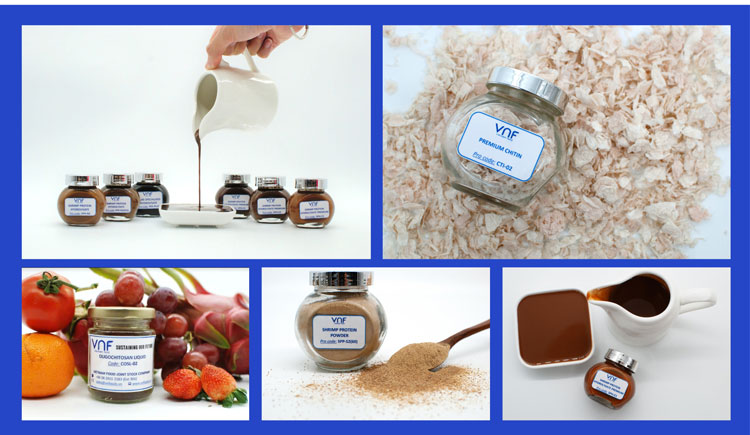
In addition, VNF faced challenges due to the lack of standardized regulations in the production of products such as Chitosan. At that time, Vietnam did not have clear standards for Chitosan, resulting in a lack of control over its market, with varying prices and quality. To address this issue, we actively collaborated with government agencies to establish a set of baseline standards for Chitosan, which have now been approved. This represents a significant effort on our part to shape and develop the Chitosan industry in Vietnam.
VFM: Iceland has been highly successful in utilizing by-products from cod. What lessons can Vietnam draw from this economic model?
Nguyen Van An: Before beginning research on the by-product production model from shrimp, VNF consulted the by-product production model from cod in Iceland. We found this model particularly interesting, especially in the early stages when the cod industry faced challenges similar to those of the by-product industry in Vietnam today: focusing solely on the main product while neglecting the by-products.
The Icelandic cod industry has faced catch quotas imposed by the government. As the industry developed to a certain point, these quotas became a significant barrier to growth. However, the Icelandic government quickly realized that the value of cod lies not only in the main product but also in its by-products. As a result, they decided to invest in science and technology to maximize the value derived from these by-products.
This is also a lesson that VNF learned while addressing the by-product issue in the shrimp industry. We understand that it’s not just about producing what’s available, but also about researching and meeting market demands. By fostering close collaboration among stakeholders, from scientists and manufacturers to communicators and consumers—VNF has built an ecosystem that supports the by-product industry.
As a result, the Icelandic cod industry currently reuses up to 95% of its by-products, while the shrimp industry in Vietnam reuses only 4% of its shrimp by-products to produce chitin. However, thanks to the efforts of VNF, we have increased the reuse rate from 60% to 80%. This demonstrates the significant potential of the by-product industry and the sustainable development we are striving for
VFM: Could you share your perspective on the relationship between science, technology, and seafood by-products? In your opinion, which new technologies and trends will play a key role in advancing the development of the seafood by-products processing industry in the future?
Nguyen Van An: Science and technology are crucial drivers of development in the byproduct industry, particularly in enhancing the value of products. Without technology, byproducts would remain as raw materials, making it difficult to transform them into high-quality products. Therefore, from the outset, we have acknowledged the need for substantial investment in technology.
VNF follows a biotechnology approach, in contrast to the traditional chemical-based method. Biotechnology allows us to extract active ingredients while preserving their integrity, ensuring their effectiveness when incorporated into products. This process requires extensive research and substantial investment.
Besides technology, the equipment must also be modern and automated to improve efficiency. I believe that any business aiming to develop the by-products industry must invest in technology, even if the investment costs must be higher compared to traditional methods. This is crucial, as new technology can extract and enhance the value of active ingredients, helping us achieve the goal of creating high-value products
VFM: In your opinion, how can Vietnam’s seafood industry maintain its position in the international market, reduce excessive reliance on foreign investment, and close the ‘billion-dollar gap’ the country is currently facing?
Nguyen Van An: There are four key factors we need to focus on to maintain Vietnam’s position in the global seafood industry and close the “billion-dollar gap”.
Firstly, there is the issue of self-reliance in raw material sources. Currently, about 80% of seafood raw materials are still imported, which not only increases production costs but also affects product quality. Vietnam has a rich agricultural resource base, yet this potential has not been fully exploited. Significant investments are needed to develop domestic raw material sources, reduce dependency on imports, improve product quality, and lower costs
Secondly, there should be a shift towards higher-value processing. The seafood industry can no longer depend solely on basic processing and exports as it did in the past. For instance, Ecuadorian shrimp industry, once relatively unknown, has now risen to the forefront by focusing on exporting whole frozen shrimp.
Meanwhile, Vietnam holds a competitive edge in producing value-added shrimp products, and we must continue to leverage this strength for further growth.
In addition, product quality is a crucial factor. To maintain consistent quality, Vietnam needs to develop sustainable farming models and minimize the use of inorganic chemicals, as international market trends increasingly demand clean and safe products
Finally, domestic businesses need to strengthen the supply chain from input to output. Prioritizing the use of local materials will help reduce costs and increase the level of localization, thereby enhancing competitiveness. Changing the mindset about the use of chemicals in production is also crucial, as many chemicals, while providing quick results, can cause long-term harm to the environment. Once we change this mindset, many issues will be resolved.
VFM: Could you share more about VNF’s upcoming strategic directions?
Nguyen Van An: In the coming period, VNF will continue to focus on developing the value chain from raw materials to final products. Our top priority will be to increase the recovery of various by-products. Vietnam produces approximately 160 million tons of agricultural by-products each year, yet VNF currently utilizes only a small portion of this resource. This presents a significant opportunity for further utilization and growth.
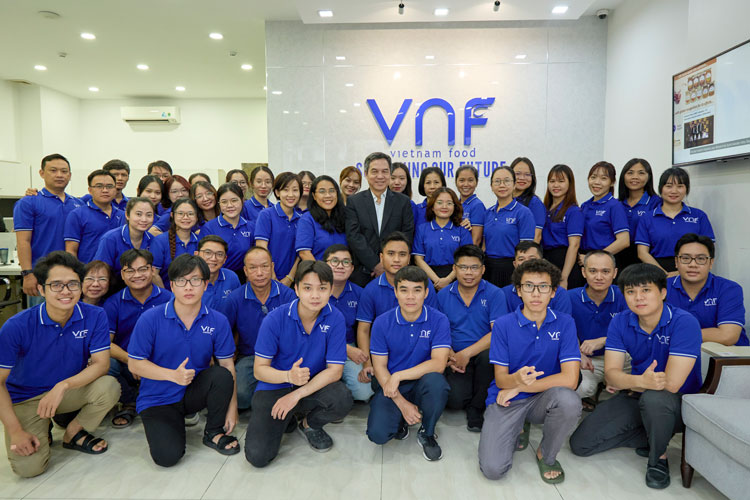
We are also upgrading our technology to extract more bioactive compounds and enhance their value. For example, VNF’s hydrolyzed products, which are currently in development, have already been applied in livestock and agriculture. In the future, we aim to expand their applications to the food and functional food sectors, such as children’s milk, nutrition for the elderly, and food for athletes. This will not only improve product quality but also increase the brand value of VNF.
Currently, VNF has six application products across various fields, including crop cultivation, animal husbandry, pet food, food, functional food, and industry. We will continue to develop new applications as there is still significant potential in these areas.
The market for VNF products is focused on two main directions. First, we are expanding into international markets. Some of our products have already been exported, and we aim to further increase this number. Through our interactions with international markets, we have found that many partners appreciate VNF’s sustainable development model. Second, we aim to provide more products to domestic farms through the B2B2F model, as we currently mainly operate under the B2B model.
VNF will continue to promote technology, develop new products, and expand its markets to contribute to the sustainable development of Vietnam’s seafood industry.
VFM



